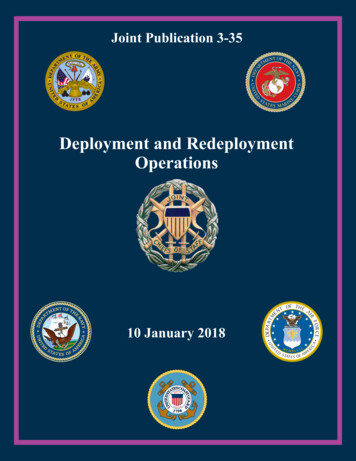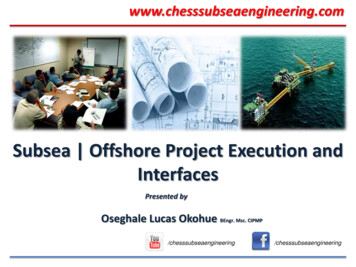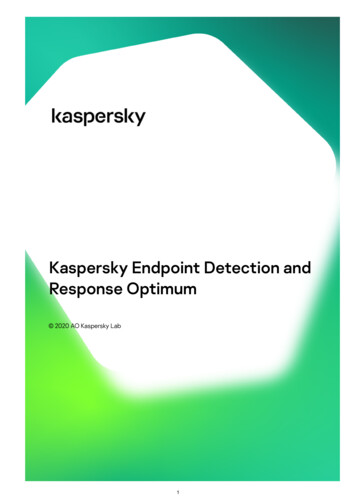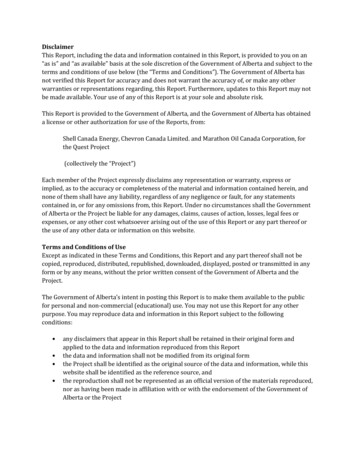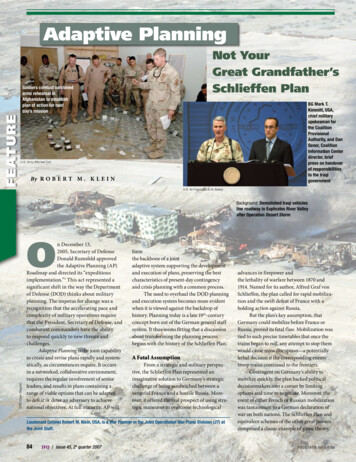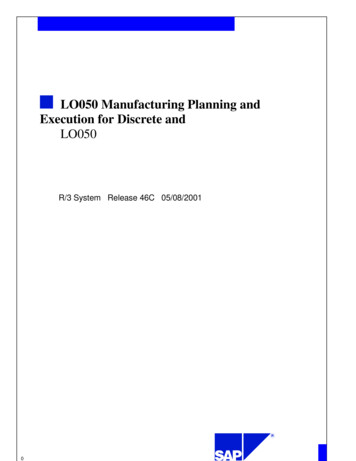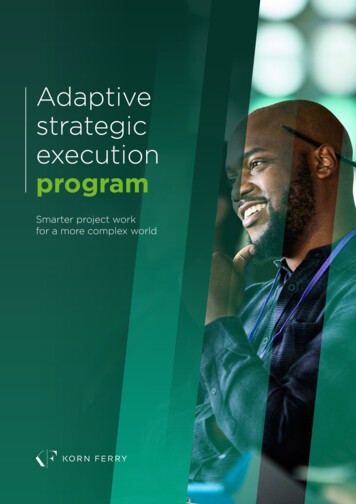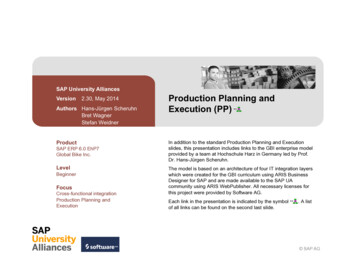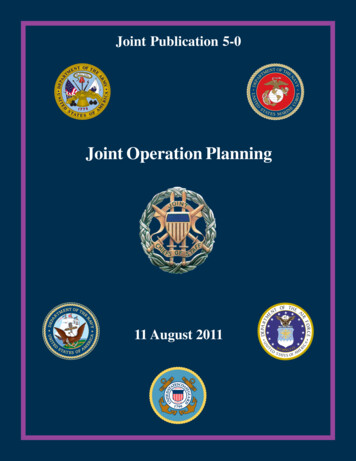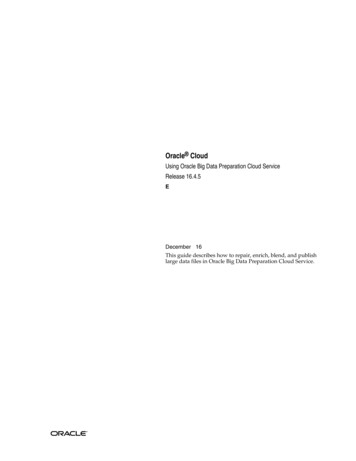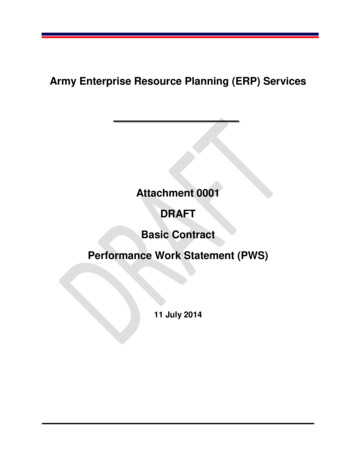
Transcription
PLANNING, PREPARATION, AND EXECUTION OF ASME SECTION XI 10-YEAR REACTORVESSEL EXAMINATIONS AT THE POINT BEACH NUCLEAR PLANTSteven J. ToddIHI Southwest Technologies, Inc.6766 Culebra RoadSan Antonio, Texas USARoger A. Bardo and William A. JensenNextEra Energy Resources Point Beach, LLC6610 Nuclear RoadTwo Rivers, Wisconsin USAABSTRACTPerformance of an American Society of Mechanical Engineers (ASME) Section XI-required reactorpressure vessel (RPV) examination is an infrequent evolution for utility personnel. This paper willaddress the planning, preparation, execution, and lessons learned by both utility and vendor personnelduring the Point Beach Nuclear Plant’s (PBNP) 4th 10-Year RPV examinations on both units withinapproximately four (4) months of each other. The use of the “High Impact Team” (HIT) concept, as wellas publication of the bid specification several years in advance of the scheduled examinations enabled bothutility and vendor personnel time to carefully plan and execute the work in a safe manner.BACKGROUNDASME Section XI (Rules for Inservice Inspection of Nuclear Power Plant Components) requires that theRPV welds and interior components be examined on a periodic basis. The basis for ASME Code is a 10Year Inservice Inspection Interval, which typically means that utilities to plan and perform their 10-YearRPV examination during the last refueling outage of the Interval. For most pressurized water reactors(PWR), this is the only time that the lower internals (core barrel) is removed from the RPV, which is ahigh risk evolution. Because of this, as well as the cost in outage “critical path” time (typically 500,000USD/day), planning for this type of work is a multi-year, multi-discipline process, requiring personnelfrom almost every organization (e.g., Maintenance, Operations, Security, Regulatory Services,Procurement/Accounting, and Engineering) to work closely with the chosen vendor as a team to ensuresuccessful completion of the work scope with minimal additional impact to the site.POINT BEACH SPECIFICSPoint Beach Nuclear Plant (PBNP) is located approximately 30 miles southeast of Green Bay, Wisconsinand has been owned and operated by NextEra Energy Resources since September, 2007. PBNP consists oftwo (2) Units, both Westinghouse-designed, 132 inch (335.28 cm) inside diameter (ID) two-loop PWR’swith 34-inch (86.36 cm) Outlet, 32-inch (81.28 cm) Inlet, two (2) 4-inch (10.16 cm) Safety Injection/CoreDeluge (SI) Nozzles (Figure 1). Both units were designed and built in the mid- to late 1960’s and weresome of the earliest PWR’s in the United States to commence commercial operation. Due to the largenumber of nuclear plant orders being processed by Westinghouse at that time, PBNP’s Unit 1 RPV wasfabricated by Babcock and Wilcox, at their Mount Vernon, Indiana plant and the Unit 2 vessel wasfabricated by Combustion Engineering, at their Chattanooga, Tennessee facility. The nozzle to ReactorCoolant System (RCS) and SI piping welds were made with stainless steel with a stainless steel“buttering” on the nozzle (i.e., no Alloy 82/182/600 material was used). Unfortunately, due e to the age ofthese units (fabrication circa 1967-68), a great deal of detailed information on the welding and any repairsof the RPV nozzles and piping tie-in welds was apparently not considered important for archival records,and thus were not kept for reference.591
Figure 1 3.5 inch (8.88 cm) ID Safety Injection/Core Flood NozzlePBNP Unit 1 commenced commercial operation on December 21, 1970 followed by Unit 2 onOctober 1, 1972. PBNP’s first full RPV examination was performed during the Unit 2 “pre-service” in theearly 1970’s. This examination was performed with a flange-mounted RPV examination tool which wasfabricated by Programmed and Remote (PaR) Systems and Southwest Research Institute (SwRI) and paidfor in part by the Wisconsin Michigan Power Company (WMPCo) - the original owner of PBNP. Thefirst tool was delivered to PBNP in February, 1971 and was originally named the ISI-2, InserviceInspection Device. Over the years, it became more commonly known as the “PaR Device”.PBNP is currently in its 4th 10-Year Inservice Inspection Interval and is committed to the 1998Edition through the 2000 Addenda of the American Society of Mechanical Engineers Boiler and PressureVessel Code, Section XI, “Rules for Inservice Inspection of Nuclear Power Plant Components.” PBNPhas been granted a 20-year extension to its original operating license. The period of extended operationfor Unit 1 commenced on midnight October 5, 2010, and commences on midnight March 8, 2013 for Unit2. PBNP’s 4th Inspection Interval for both Units ends on June 30, 2012.SELECTION OF AN EXAMINATION VENDORIn 2006, the Engineering Programs Group at PBNP sought out competitive bids from three (3) vendorscapable of performing 10-Year RPV examinations. At the time the bid specification was issued, theexaminations were scheduled in the Spring (Unit 2, Refueling 29) and Fall (Unit 1, Refueling 31) of 2008.After careful consideration, in December 2006, IHI Southwest Technologies (ISwT) of San Antonio Texas(formerly known as the Nondestructive Evaluation Division of Southwest Research Institute) was selectedas the vendor of choice. This was based on a number of different technical factors such as time on vessel,technical approach to the bid, compliance with the bid specification, and familiarity with the issues knownto exist in the PBNP RPVs – which ISwT (SwRI) had intimate knowledge of due to work in thedevelopment of focused-beam flaw sizing techniques with PBNP and the Ginna Nuclear Plant in New592
York during the 1980’s. Separate from the technical review of the bids, which was performed by PBNPEngineering Programs personnel using un-priced bids, the Nuclear Management Company (NMC)corporate Contracts Administration Group performed a cost review, which also found ISwT to be thevendor of choice. Based on the technical and fiscal findings, the NMC issued a contract to ISwT inJanuary, 2007, with an initial project kick-off meeting between PBNP Engineering Programs and ISwTpersonnel following immediately thereafter to begin laying the groundwork for the outages planned for2008.EXAMINATION EQUIPMENT SPECIFICSISwT used an offspring of the original PaR Device, known as the FastPaR (Figure 2), which is designedfor remote change out of the examination end-effectors (transducer packages), thus requiring only a singlemove to the vessel prior to commencement and from the vessel upon completion of the examinationactivities. The “quick-change” unit allowed for an end-effector to be docked with an underwater dockingmechanism, and then transported up to the operating floor, where it would be swapped out with a new,calibrated end-effector to continue examinations. This allowed examinations to continue with minimalinterruptions (typically 30 to 45 minutes).ISwT used two different ultrasonic (UT) data acquisition systems: the Enhanced Data AcquisitionSystem II (EDAS-II ), and the Zetec Tomoscan III/PA 32/128 phased array (PA) system (T-III). BothEDAS-II and the T-III equipment and procedures had been fully demonstrated through ASME SectionXI, Appendix VIII, as implemented by the Performance Demonstration Initiative (PDI). The RPV shellwelds were examined using conventional UT (EDAS-II ) while the nozzle-to-shell from the nozzle boreand the nozzle-to-piping system dissimilar metal (DM) welds were examined using PA (T-III). During the1998/1998 10-Year RPV examinations, PDI techniques were used on the RPV shell welds only, asdemonstrations of the nozzle-to-shell and nozzle-to-piping system welds had not been performed by anyvendor.One area that PBNP has a relatively unique challenge is the examination of the SI nozzles and DMwelds. Since the inside diameter of the nozzle/piping is approximately 3 ½ inches (8.88 cm), anytooling/end-effectors have to be extremely small and built to very close tolerances. In addition, due to thecenter mast design of the ISwT FastPaR tool, the end-effector had minimal clearance when maneuveringaround the SI nozzle extension. This end-effector was required to extend into the SI nozzle approximately18 inches blind (i.e. no visual validation of the search unit location). This meant that ISwT personnel hadto rely solely on the encoded positional readouts and UT data (0-degree profilimetry and PA) to validatethat they were at the correct position inside the nozzle to perform the nozzle-to-shell or DM weldexamination. In addition, due to the challenges involved in the original PDI testing, the scanning timerequired for the SI nozzle to shell and DM welds was almost four hours per nozzle.The visual examination portions of the examination scope were completed using cameras mountedon the FastPaR and on the PBNP-owned Deep Ocean Engineering, Phantom 150 remotely operatedvehicle (ROV).PLANNINGDue to the enormous impact on the overall schedule of the planned refueling outages, the 10-Year RPVexamination received an extremely high level of attention from management both at the site, and the NMCcorporate offices. Approximately two months after contract award in January 2007, two things occurred:(a) WE Energies (the owner of PBNP) and the NMC, announced the sale of PBNP to FPL Group (nowknown as NextEra Energy) which would occur in late 2007; and (b) PBNP station managementcommenced the High Impact Team (HIT) process for the Spring 2008 outage (U2R29). Due to theirfamiliarity with both ASME Section XI and the overall job scope, the PBNP NDE Level III and InserviceInspection Coordinator Bardo were chosen as the HIT Lead (Day Shift) and Back-up (Night Shift Lead),respectively.593
Figure 2 ISwT FastPaR DeviceThe HIT consisted of personnel from Operations, Maintenance, Radiation Protection, Security,Nuclear Supply Chain, and Production Planning (Outage Scheduling), as well as several personnel fromEngineering Programs. In addition to the formal members of the HIT, a number of other personnel wereengaged, including the head of the Refueling Services HIT, the Yard Coordination HIT, ContainmentCoordination HIT, and the In-Processing (Security/Badging/Training) HIT. These groups wererecognized as playing an integral part of the overall success of the 10-Year examination. HIT meetingswere initially held approximately once every three weeks, with a plan to increase the frequency to weeklyapproximately 3 months prior to the outage (about December, 2007). However, shortly after theacquisition of PBNP by the FPL Group, the schedule for the 10-Year examination was challenged by FPLGroup personnel based on other work that was scheduled during the same outage timeframe. Due to thischallenge, PBNP Engineering Programs personnel spent several weeks validating that the examinationscould be moved from 10 years to almost 12 years since the last examination.In spite of the approximately 18 month delay in the examination schedule, PBNP and ISwTpersonnel continued the HIT meetings, but only on a monthly basis. In addition to the HIT meetings onsite, the PBNP ISI Coordinator, NDE Level III, and the Authorized Nuclear Inservice Inspector attended athree day training class in data acquisition and analysis on both EDAS-II and the T-III equipment, aswell as a demonstration of the cameras that would be used to perform the enhanced visual examination(EVT-1) of the nozzle inside radius sections (IRS) in accordance with ASME Code Case, N-648-1,“Alternative Requirements for Inner Radius Examination of Class 1 Reactor Vessel Nozzles, Section XI,594
Division 1,” as modified by United States Nuclear Regulatory Commission (USNRC) Regulatory Guide1.147. In addition to training on the equipment, techniques, and procedures, PBNP and ISwT personnelcarefully reviewed all areas of previously recorded indications in both the RPV shell welds and the nozzleto-piping systems welds. There were several areas of concern noted in both Unit 1 and Unit 2’s pipingwelds, which PBNP personnel felt could pose a risk of being considered inside surface (ID) connected dueto their proximity and the rules of Section XI, as well as a nuance of the PDI demonstration.Since no vendors had successfully demonstrated the capability to meet the through-wall sizingacceptance criteria of Appendix VIII, Supplements 2, 3, and 10 [0.125 inch (3.175 mm)] root mean square(RMS), the USNRC issued Regulatory Issue Summary (RIS) 2003-01, “Examination of Dissimilar MetalWelds, Supplement 10 to Appendix VIII of Section XI of the ASME Code” on January 21, 2003. AfterRIS 2003-01 was issued, a compromise position was reached between U.S. utilities and the USNRCregarding how to deal with the issue of non-qualified sizing. The compromise was the use of a request forrelief (RR) from the requirements of the U.S. Code of Federal Regulations (CFR) governing inserviceinspection [10 CFR 50.55a(g)(4)].When originally designed, the PDI ID examination test specimens were fabricated with flaws whichall originated at the ID surface, since that is obviously the concern from an inservice inspection standpoint(i.e. – service induced cracking). Unfortunately, the technologies that all U.S. PWR RPV examinationvendors used found other, non-inservice related flaws (e.g., slag, lack-of-fusion, clad-to-base metalindications, etc.). Operating experience from a number of utilities who had performed their 10-Year RPVexaminations within 2-3 years prior to PBNP showed that there were a large number of indications whichwere “buried”, but were recorded and had to be evaluated through the requirements of ASME Section XI,IWB-3500.Based on the requirements discussed above, on March 13, 2008, PBNP submitted RR-21 to use thealternatives covered under ASME Code Case N-695, “Qualification Requirements for Dissimilar MetalPiping Welds Section XI, Division 1,” along with documentation through EPRI of the actual RMS error(RMSE) of the vendor. The NRC granted PBNP’s request on August 25, 2008 with no additionalrestrictions.Due to the risks involved in the examination of the DM welds, contingency planning was requiredby PBNP and NextEra Energy corporate management. This planning included putting contracts in placewith the Original Equipment Manufacturer (OEM) for engineering support and validation of the PBNP“Flaw Evaluation Handbook”, as well as a contract amendment with ISwT for the deployment of an eddycurrent (ET) end-effector in case UT indications were recorded near the inside surface of the DM welds.The use of ET would assist PBNP personnel in validating that any indications recorded were notconnected to the “wetted surface” (i.e. – ID of the pipe), and thus were fabrication-related indications andnot service-related flaws.PBNP Engineering Programs personnel also utilized the delay in the examination schedule to walkdown areas in the specific containments to validate information provided in the bid specification and toensure that the ISwT equipment would all fit in the area(s) designated by the Containment CoordinationHIT. These walk downs allowed Engineering Programs and ISwT to have a higher level of comfort withthe plans which had been previously made and validated many assumptions that had been used forplanning the work. This additional outage prior to the examination assisted greatly with making theoverall project flow more smoothlyAnother change in the way business was done at PBNP was the use of Refueling Services vendorfor a number of tasks that had previously been performed by PBNP Maintenance and Operationspersonnel since the start of commercial operation. This was a large change for those organizations, as wellas Engineering Programs and required dealing with a whole new group of individuals. During the sixmonths prior to the Fall 2009 refueling outage (U2R30), a number of meetings were held with theRefueling Services vendor representatives in an attempt to ensure that the non-site personnel wouldunderstand the needs of ISwT and Engineering Programs.While PBNP personnel were preparing for the Fall outage, ISwT personnel were also busy withpreparations for the job. During the Summer of 2009, ISwT personnel completely disassembled the595
FastPaR and rebuilt/refurbished most components. In addition, based on Operating Experience fromanother utility/vendor where an RPV examination tool broke and parts fell into the cavity/RPV, ISwTperformed visual and liquid penetrant examinations of all the welded parts of the FastPaR. Theseexaminations revealed some areas which, although were not structurally defective, were repaired to ensurethat no issues would occur. ISwT also performed a number of check-outs on the SI nozzle tool, as it was afirst-of-a-kind (FOAK) deployment of this tool design.During the final two months prior to U2R30, additional challenges were hurled at EngineeringPrograms, including a lack of site power for the ISwT data acquisition trailer, which was to be positionedjust outside the radioactive controlled area (RCA) fence. During the previous Unit 2 10-Year examination(Winter 1998/99), power was run from a warehouse approximately 75 feet (22.86 meters) away. Thispower receptacle was unavailable due to the replacement of the three main transformers as part of thelong-term Power Uprate Project. Due to the small footprint of the PBNP site, there was only one transportpath for these transformers to follow, that that cut between the warehouse and the ISwT trailer location.Because of this challenge, Programs Engineering personnel had to rent a temporary diesel generator andarrange for fueling services for the entire time that ISwT would require power to their acquisition/analysistrailer.U2R30 - EXECUTION AND SUCCESSIn October 2009, U2R30 commenced. While faced with a myriad of minor issues, such as coordination ofthe various support groups required to move the examination equipment from the yard into the Unit 2containment, the overall examination process went well. The equipment was moved into containment, setup, placed on the RPV, and ran throughout the examination process with no significant problems. The twoareas of concern – the FOAK deployment of the SI Nozzle Tool and the DM weld end-effectors worked asplanned with few problems. There were several indications which required some additional analysis time,including consultation with the Electric Power Research Institute’s (EPRI) PDI Administrator forvalidation. However, the indications were all deemed allowable in accordance with ASME Section XIwith no analytical evaluations required (IWB-3600). There were, unfortunately, a minor injury (a fingerprick with safety wire) and a single, low-level, personnel contamination event (PCE), which spoiled anotherwise flawless execution. However, radiation exposure was excellent, with just over 400 mR (0.0040sv) expended with over 1,400-person hours logged in the RCA.U1R32 - EXECUTION AND CHALLENGESAfter U2R30, both PBNP and ISwT personnel felt that only minor adjustments to execution plans wererequired. Unfortunately, in spite of all efforts to the contrary, they were mistaken. Between U2R30 andU1R32, ISwT performed preventative maintenance on the FastPaR and associated equipment again toensure that it was completely ready for the outage in March, 2010. This maintenance included tear-downsand re-builds of most components, replacement of some parts, and re-assembly and check-out of the entireFastPaR at ISwT’s facility in San Antonio. These check-outs revealed no problems, and the equipmentwas then disassembled, boxed up, and shipped to PBNP approximately one week prior to the outage.Based on lessons learned from U2R30, PBNP requested that ISwT ship the equipment a week earlyin order to be able to affect a modified move-in sequence. The majority of the equipment required insidecontainment could be moved through the upper (personnel) airlock. Because of this, as well as the supportrequired from PBNP Maintenance for forklift, crane operators, and riggers; Engineering Programspersonnel arranged for that equipment to be moved into the “truck bay” located in the Primary AuxiliaryBuilding (PAB) located between Unit 1 and Unit 2 containments. The equipment was then surveyed byRP and rigged/lifted across the spent fuel pool to a mezzanine level inside the PAB. It was then stored ina fan room just outside Unit 2 containment, where it was out of the way. Once the Unit 1 containment wasopen for equipment move-in, it was shuttled back across the mezzanine and into the Unit 1 fan room oncarts and offloaded into the contaminated area for transport into containment. This worked very well for596
all parties involved (RP, Maintenance, and ISwT) and allowed other work to continue until the final threepieces of equipment were ready to be moved in through the lower airlock (equipment hatch).ChallengesDuring the final equipment move-in process, several challenges arose – the first of which were questionsby the Operations Team Room regarding the ability to close the lower airlock within the time-to-boil“window” that existed at the time (approximately 30 minutes). Based upon discussions with ISwT, theDay Shift Lead could not guarantee that, during the movement of the final piece of equipment (theFastPaR mast), the containment closure time could be met. This required an adjustment to the overallschedule to wait until the time-to-boil issue was not a concern. The second challenge was the fact that,during move-in, the “lower unit” of the FastPaR was found to have one of the transport bolts jammed,which caused a delay of almost an hour to remove the bolt. The third move-in challenge was the fact thatthe Unit 1 lower airlock elevation layout was slightly different than Unit 2. There was an air duct thatextended a greater distance out into the “free zone” than Unit 2, which caused the riggers and craneoperator to question if the mast could be moved in. Personnel from ISwT, the Containment Coordinator,and the Day Shift Lead, along with the crane operator and riggers stopped the work and discussed a liftplan that would address the concerns. This caused another delay, but it brought the mast up to therefueling floor (66 ft. elevation) safely.The next area that was challenged was the equipment itself. During assembly of the FastPaR on the66 ft., a break device was identified as malfunctioning. The device was swapped out and assemblycontinued. Unfortunately, that was not the last challenge. There was a Foreign Material Exclusion (FME)zone event due to a spool of safety wire falling into the open refueling cavity, and then there were severalcomputer/software issues that slowed data acquisition also. The major issue occurred though when thePaR Operator inside containment noticed that the device did not appear to be operating correctly. It wasplaced in a safe condition and removed from the RPV. When it was removed, it was quickly determinedthat the device had come off center from its internal guides. This repair was a FOAK evolution for PBNPand took over 24 hours to plan and execute. After the repair was completed, the device was checked-outand returned to the vessel to continue scanning. The device performed well and data was collected on allwelds with the exception of the SI nozzles. There were some problems with the SI Nozzle tool, includingbinding and water intrusion in the air-operator lines. Trouble-shooting happened over a number of hoursin parallel with the other examinations, but finally the SI nozzle work had to get started. During the startof the first examination, the SI nozzle tool became partially lodged in the nozzle. A plan was thenformulated to “rescue” the tool using PBNP Reactor Engineering poles and other plant-suppliedequipment. The tool was extracted from the nozzle without a great deal of problems, but the extensionfunction which was required to reach the DM weld would not work. It was finally determined by the DayShift Lead that the nozzle-to-shell welds would be examined and the SI DM welds would have to beexamined during the next Unit 1 outage in 2011. This was a blow to the entire 10-Year RPV team, but itwas felt that no additional time could be expended on the vessel, as it was coming close to impacting thecritical path of the outage.The examinations revealed one (1) indication of concern. On the “A” Inlet Elbow to Nozzle DMweld (RC-32-MRCl-AIII-03), an indication was recorded that was close enough to the inside surface tofall within the “surface by proximity” rules when the RMSE was applied in accordance with PBNP ReliefRequest RR-21. This meant that the ET end-effector needed to be deployed in order to validate that theindication was not ID connected. This activity was scheduled just before the work on the SI nozzles(discussed above), and in the meantime, personnel from Westinghouse and NextEra/FPL Group corporateheadquarters were provided information on the flaw and multiple discussions were had regarding how todeal with the indication. Ultimately, the indication required acceptance by Analytical Evaluation perIWB-3600, which was then communicated to the USNRC via conversations with the Senior ResidentInspector as well as the Regional Inspector and then followed up with written notification.597
From a radiological and industrial safety standpoint, the Unit 1 outage was very successful. Therewere no injuries and no personnel contamination events. In spite of the problems encountered, theradiation exposure to personnel was less than 450 mR (0.0045 Sv) with over 1,400 person-hours logged inthe RCA.CONCLUSIONS10-Year Reactor Vessel examinations are an infrequently performed task for most utility personnel andplanning cannot start soon enough. Based on the experiences over the past three years, the followingitems should be considered when planning for such an activity:1. The bid specification should clearly state all site requirements and how the bidder will addressthem, including any procedure review/revisions, training, demonstrations, or meetings that should beconsidered as basic “in-scope” work. In addition, the bids should clearly have any site supportrequirements identified as well as the site’s expectations for Foreign Material controls, Security/Badgingrequirements, and any penalties that would be imposed upon the vendor for violation of thoserequirements.2. The use of the High Impact Team concept that includes various work groups on site as well asthe examination vendor is an excellent method to ensure that neither the implementing organization(Engineering Programs at PBNP) nor the vendor are complacent with their planning and preparation.3. The vendor should be considered a team member and not treated as someone who will justshow up, do a job, and leave. Communication to vendor personnel by the site should occur frequently andthey should understand how important their job is to the overall success of the outage, as well as the futureof the plant.4. A clear communication plan for both vendor-to-site contact communication as well as projectto-outage control center communications. This helps keep rumors to a minimum and helps keep personnelin the field from being distracted by non-project personnel wanting status updates.5. Site project personnel should become intimately familiar with the equipment, procedures, andprocesses so that when challenges arise, they can understand some of the bases for recommendations thatmay come from the vendor.THANKSThe authors would like to thank the following individuals and or groups for their support over the pastthree years:Hartford Steam Boiler Insurance and Inspection Company:Mr. Jeffrey BukowieckiNextEra Energy - Point Beach Nuclear Plant:Messrs. Ronald Barker, Steve Brown, Stephen Clark, Charlie Trezise, Carrie Welnicke, and everyone inRadiation Protection and Maintenance.IHI Southwest TechnologiesMessrs. Carlos Barrera, Jesse Delgado, Hector Diaz, Joel Godwin, and Ramon Villagomez.REFERENCES1)United States Nuclear Regulatory Commission (USNRC) Regulatory Issue Summary 2003-01,“Examination of Dissimilar Metal Welds, Supplement 10 to Appendix VIII of Section XI of theASME Code,” USNRC, Washington, D.C., January 21, 2003.2)American Society of Mechanical Engineers (ASME) Boiler and Pressure Vessel Code, SectionXI, Division 1, “Rules for Inservice Inspection of Nuclear Power Plant Components, 1998 Editionthrough 2000 Addenda,” ASME, New York, New York, 2000.3)ASME Code Case N-695, “Qualification Requirements for Dissimilar Metal Piping Welds Section598
4)5)6)7)8)XI, Division 1,” ASME, New York, New York, May 21, 2003.Electric Power Research Institute (EPRI) letter from Carl Latiolais to William A. Jensen,“Summary of IHI Southwest Technologies Supplements 2 & 10 Depth Sizing Results Obtainedfrom the Inside Surface,” EPRI, Charlotte, North Carolina, February 25, 2008.FPL Energy Point Beach letter NRC 2008-0017, “10 CFR 50.55a Request, Relief Request RR-21,Examination of the Reactor Pressure Vessels Fourth Ten-Year Inservice Inspection ProgramInterval,” March 14, 2008.USNRC Letter to Mr. Larry Meyer, Site Vice President, “Point Beach Nuclear Plant, Units 1 and2 – The Fourth 10-Year Interval Inservice Inspection Program Plan Requests for Relief No. RR-21(TAC Nos. MD8319 and MD8320), Washington, D.C., August 25, 2008.IHI Southwest Technologies, “Exam Plan – Automated Ultrasonic Examination of the ReactorPressure Vessel at Point Beach Nuclear Plant Unit 2,” San Antonio, Texas, September, 2009.IHI Southwest Technologies, “Exam Plan – Automated Ultrasonic Examination of the ReactorPressure Vessel at Point Beach Nuclear Plant Unit 1,” San Antonio, Texas, January, 2010.599
ASME Section XI (Rules for Inservice Inspection of Nuclear Power Plant Components) requires that the RPV welds and interior components be examined on a periodic basis. The basis for ASME Code is a 10-Year Inservice Inspection Interval, which typically means that utilities to plan and perform their 10-Year
